|
Australië, australia
 Nederlands /
Dutch Nederlands /
Dutch
Subpage bugs in
the garden: "Water
bugs"
Shield
bugs (Pentatomoidea)
Seed
bugs (Lygaeidae)
Cicadas
Aphids
Plant bugs, Miridae in the garden.
Information about bugs:
True bugs can be found both in and on water and on land. They also have a
sucking mouthparts known as a rostrum.
With this rostum they suck juices from all kinds. That can be plants and seeds, but also insects and other animals. They belong to the order Hemiptera
like aphids
and cicadas.
The true bugs have forewings that are hardened at the base and membranous
at the tips. They sit flat over the abdomen hiding the membranous hind
wings. Hemiptera
means “half wing. They
are held flat on the back, with the ends overlapping. (Hardened
forewings like the beetles have, but the forewings of beetles meet
together in a straight line on their back)
The larva (nymph) resembles a miniature wingless adult, although their colour and markings may be very
different. The nymphs progress
through a series of moults (known as instars).
The wings are developed in the last instar. ( incomplete metamorphosis, there is not a pupal
stage). There are five instars.
In and near water, these families are on this website: Corixidae, Gerridae,
Hydrometridae, Nepidae, Naucoridae, Notonectidae, Saldidae.
There are many families. Well known is the superfamily Pentatomoidea, which is divided into 14-15 families.
Such as the families Stink bugs (Pentatomidae), Acanthosomatidae, Burrower Bugs
(Cydnidae), Jewel bugs (Scutelleridae), ebony bugs (Thyreocoridae) with in the Netherlands
only the Thyreocoris scarabaeoides and since 2021 the family Plataspidae with in the Netherlands
only the Thyreocoris scarabaeoides.
Other true bugs families on this website are: Minute pirate bugs, Flower bugs (Anthocoridae) , Squash bugs,
Leaf-footed bug (Coreidae) , Seed bugs, Ground bugs (Lygaeidae),
Plant bugs (Miridae), Nabidae, Scentless plant bugs (Rhopalidae), Reduviidae,
Lace bugs (Tingidae).
|
Plantbugs, Miridae. Suborder of the bugs (Heteroptera). This is a very large
family with over 10.000 species in the world. The bugs in many subfamilies are
different shaped. Some species are known because they are a pest to agriculture.
They feed on plant juices. These juices are absorbed with their snout.
Plant bugs, Miridae can be distinguished from the pirate bugs, Anthocoriden bugs
and the groud bugs, Lygaeidae by the absence of ocelli. An ocellus, plural ocelli is also called a
simple eye or pigment pit. Many insects have three on their foreheads. They seem to distinguish light and dark.
Therefore, these bugs has the Dutch name "blind bugs". But of course they can see well.
Subfamily Bryocorinae.
Tribe: Bryocorini.
Small brown bugs. They are found on ferns.
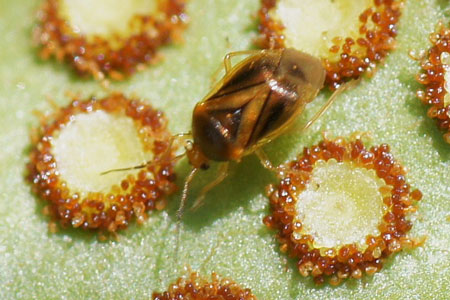 .. ..
 Nymph:
Nymph:  . .  Monalocoris filicis. Tribe:
Bryocorini. Subfamily Bryocorinae. Family Plant Bugs,
Miridae. Monalocoris filicis. Tribe:
Bryocorini. Subfamily Bryocorinae. Family Plant Bugs,
Miridae.
A small golden-brown
bug with a pale orange head.
You can find it on the ferns. Monalocoris filicis feeds primarily on sperangia. (containing the spores). On the
picture it is on the underside of a fern. The nymph on a hart's-tongue fern.The whole year. The adult
overwinters. One
generation.
Length 2-3,1 mm. Palearctic. Photos 2-7-2012, 8-8-2016. |
Tribe: Dicyphini. Slender bugs to 5.5 mm.
 .. ..
 . .
 Nymh:
Nymh:  Campyloneura virgula.
Tribe Dicyphini. Subfamily Bryocorinae. Family Plant Bugs,
Miridae.
Campyloneura virgula.
Tribe Dicyphini. Subfamily Bryocorinae. Family Plant Bugs,
Miridae.
The nymphs have red yellow striped antennae. The adult bug on this
picture also has striped antennae. But usually
they haven't. The cuneus is bright yellow.
It's a predatory bug and it feeds on insects such as aphids and red mites. They are found mainly in deciduous trees
such as hazel, hawthorn and oak. In the garden I see them on other trees or shrubs. Like
redflower
currant, birch and even bamboo.
Length 3,9-4,7 mm. July - October. The adult overwinters. Palearctic, but now also in North America.
Photos 16-6-2009, 15-7-2012. German: Rotbeinige Baumwanze French:
Punaise à pattes rousses.
 An old photo of an issus with a nymph Campyloneura virgula.
An old photo of an issus with a nymph Campyloneura virgula. |
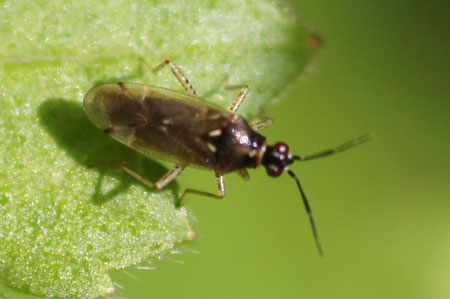 .. ..
 . .
 Dicyphus globulifer. Tribe
Dicyphini. Subfamily Bryocorinae. Family Plant Bugs,
Miridae. Dicyphus globulifer. Tribe
Dicyphini. Subfamily Bryocorinae. Family Plant Bugs,
Miridae.
A small bug with pale legs. The antennae are
entirely black. The elytra is brownish, the head is black. Striking are
the white sides of the scutellum.
They live on plants of the pink family (Caryophyllaceae). They are often
found on red and white campion (Lychnis). All year. The adult
overwinters. Probably
several generations.
Length up to 3.6-4 mm. Palearctic. Photos 20-7-2011, 11-3-2014, 15-5-2014. |
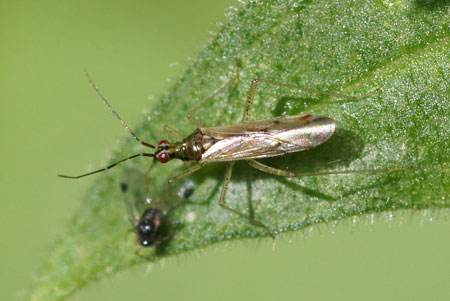 .. ..
 . .
 Nymph: Nymph:
 Dicyphus
errans. Tribe Dicyphini. Subfamily Bryocorinae. Family Plant Bugs, Miridae. Dicyphus
errans. Tribe Dicyphini. Subfamily Bryocorinae. Family Plant Bugs, Miridae.
A predatory bug like you can see in the picture. In real you don't recognize it immediately as a bug, because it is so small, slim and shiny. Like a small wasp or gnat.
It lives on many different plants. June - October. Probably two generations. Length
4,4-5,2 mm. Palearctic. Photos 16-8-2011, 6-7-2013, 31-7-2017.
|
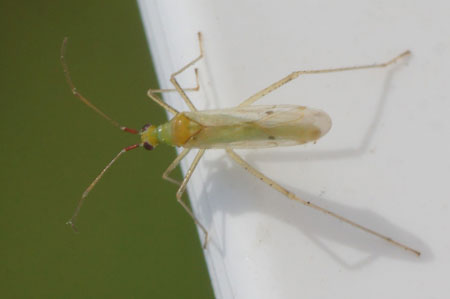 .. ..
 Nymph: Nymph:
 Dicyphus
epilobii. Tribe Dicyphini. Subfamily Bryocorinae. Family Plant Bugs,
Miridae. (1
km from our home) Dicyphus
epilobii. Tribe Dicyphini. Subfamily Bryocorinae. Family Plant Bugs,
Miridae. (1
km from our home)
On hairy willowherb not far from our garden. I haven't seen
it on the hairy willowherb at our pond.
A yellow-green to green-brown bug. Of the brownish antennae, the first segment is remarkably red. Yellowish green legs.
It lives on hairy willowherb (Epilobium hirsutum) and sucks both on the plant and on insects.
May - October. It overwinters as an egg. Two generations in a year.
Length 4,1-5,3 mm. Palearctic.
Photos 23-8-2017. |
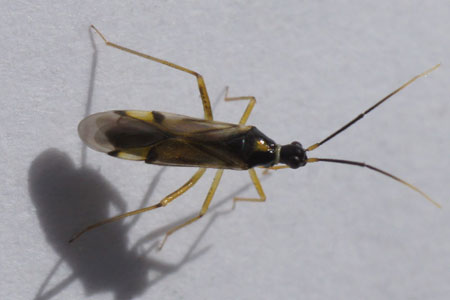 .. ..
 Tupiocoris rhododendri. Tribe
Dicyphini. Subfamily Bryocorinae. Family Plant Bugs, Miridae. (200 meter
from our home)A black head, thorax and
scutellum. The thorax with a white ring. Slightly transparent
forewings with a yellow cuneus. Yellow legs. Antennae are black and yellow. Tupiocoris rhododendri. Tribe
Dicyphini. Subfamily Bryocorinae. Family Plant Bugs, Miridae. (200 meter
from our home)A black head, thorax and
scutellum. The thorax with a white ring. Slightly transparent
forewings with a yellow cuneus. Yellow legs. Antennae are black and yellow.
Rhodondendron. Both juice of young leaves and insects.
May - July. It overwinters as an egg. One generation.
Length 4.2-4.6 mm. Nearctic. Probably native to America. Now also in Europe. 1972: Described in England. 2002: Netherlands. 2004: Germany.
Photos 29-6-2016. |
Subfamily Deraeocorinae.
Tribe: Deraeocorini. Oval-shaped bugs, 5 to 10 mm.
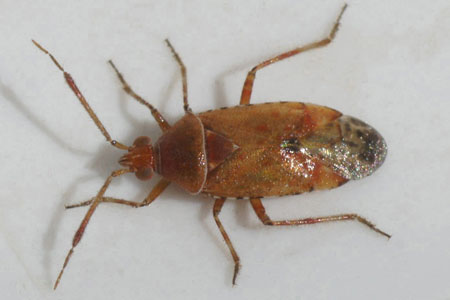 .. ..
 . .
 Alloeotomus
gothicus. Tribe: Deraeocorini. Subfamily Deraeocorinae.
Family Plant Bugs,
Miridae. Not in the garden, but in the
dunes about 4 km from our home. Alloeotomus
gothicus. Tribe: Deraeocorini. Subfamily Deraeocorinae.
Family Plant Bugs,
Miridae. Not in the garden, but in the
dunes about 4 km from our home.
An orange-brown to brown bug. Pronotum with a pale rear margin. The membrane is
pale with dark spots. It is very similar to Alloeotomus germanicus. Small differences in hairiness and distance between the eyes. This bug is determined by Berend
Aukema.
It lives on pine (Pinus) and feed on aphids and insect eggs, but also sucks the flowers
of the pine.
Palearctic: Europe, Asia (Turkey).
July - November. It overwinters as an egg. One generation, possibly two generations
in a year.
Length 5,1-6 mm. Photos 1-8-2016. |
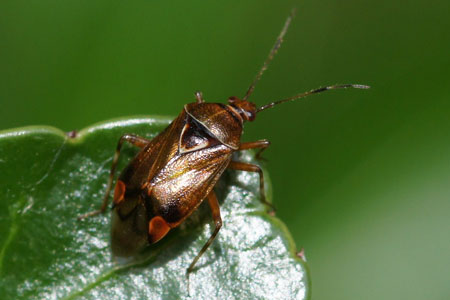 .. ..
 Deraeocoris flavilinea. Tribe:
Deraeocorini. Subfamily Deraeocorinae.
Family Plant Bugs,
Miridae. Deraeocoris flavilinea. Tribe:
Deraeocorini. Subfamily Deraeocorinae.
Family Plant Bugs,
Miridae.
The colours are variable. The male is darker than the female. The female is more brown orange. The side of the scutellum is
pale. Also pale are the front and rear margins of the pronotum. The tibia
has pale bands. The colour of the cuneus is variable, usually pale red.
It is found in many plants. Like sycamore and field maple. Probably they mainly
feed on aphids.May - September. It
overwinters as an egg. One generation.
Length 6,3-7 mm. Photos 5-8-2010. |
Subfamily Mirinae.
Tribe: Mirini. A large group of bugs, which differ in shape. Both elongated and oval.
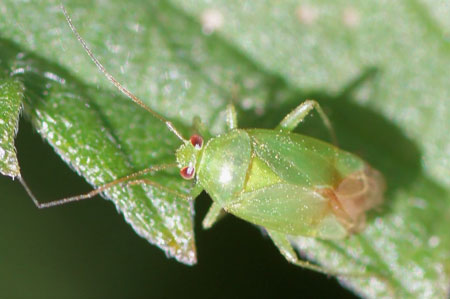 .. .. Apolygus spinolae. Tribe:
Mirini.
Subfamily Mirinae. Family Plant Bugs, Miridae.
About 1 km from our home.
Apolygus spinolae. Tribe:
Mirini.
Subfamily Mirinae. Family Plant Bugs, Miridae.
About 1 km from our home.
A shiny light green bug with a fine light hairs. Red eyes. The cuneus of the forewings is also green, but with a small black
dot at the end (see small picture). It looks like Apolygus lucorum, but
this plant bug has no small black dot on the cuneus.
It feeds on herbaceous plants. Mainly nettle, but it also sucks on dead insects. It can be harmful to hop and grape.
June - September. It overwinters as an egg. One generation in a year, under favorable circumstances there might be a second generation.
Length 5,3-6 mm. Palearctic: Erurope, Asia. Photos 18-7-2016. |
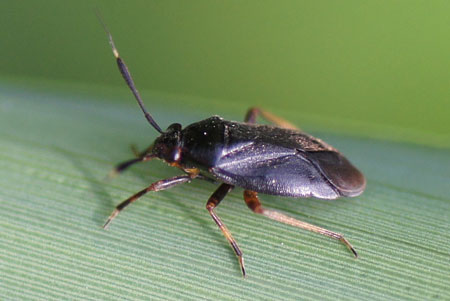 .. ..
 Capsus ater. Tribe: Mirini.
Subfamily Mirinae. Family Plant Bugs, Miridae.
Capsus ater. Tribe: Mirini.
Subfamily Mirinae. Family Plant Bugs, Miridae.
This small bug is recognizable by the dark second antenna segment, which
is swollen at the end. The third antenna segment is much thinner and light.
It feeds on grasses.
May - September. It overwinters as an egg in hollow grass stems. One generation.
Length 5,1-6,2 mm. Palearctic, but now also in North America.
Photos 14-7-2013. |
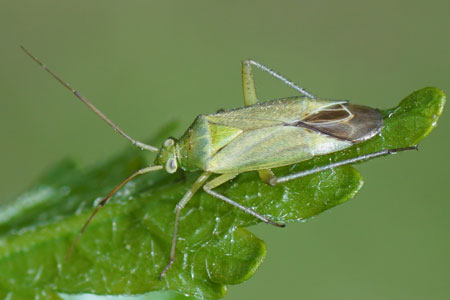 Closterotomus norwegicus. Tribe: Mirini. Subfamily
Mirinae. Family Plant Bugs, Miridae.
Closterotomus norwegicus. Tribe: Mirini. Subfamily
Mirinae. Family Plant Bugs, Miridae.
It's a green bug. Adult bugs may have a reddish tint. Two distinctive dark spots on the
pronotum.
(But Adelphocoris lineolatus has also two dark spots) They often have two dark spots
at the top of the scutellum (but not always).
Antenna segment 2 is about as long as segment 3 and 4 together.
It lives on many different plants. Like nettles, composites and clovers.
May - September. It overwinters as an egg. One generation.
Length 6-8 mm. Palearctic, but now also in North America, Australia and New Zealand.
Photo 18-6-2025. .
 nymph Photo 24-5-2011
nymph Photo 24-5-2011
|
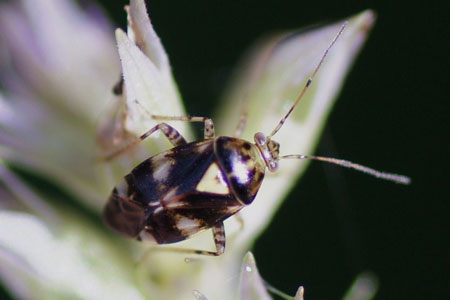 .. ..
 . .
 Common
Nettle Capsid (Liocoris tripustulatus).
Tribe: Mirini. Subfamily Mirinae. Family Plant Bugs,
Miridae.
Common
Nettle Capsid (Liocoris tripustulatus).
Tribe: Mirini. Subfamily Mirinae. Family Plant Bugs,
Miridae.
The
spots of the overwintering bugs are dark orange. The young adult bugs have white, yellow, green
spots, which will darken later.
It looks like the Orthops basalis and O. kalmii. But these plant
bugs don't have dark rings on the shins and antennae.
They occur of course on its host the nettle, but also on other plants.
The adults hibernate.
Length
3,5-5 mm.
Palearctic. Photos
27-9-2011, 11-6-2012.
German: Gepunktete Nesselwanze.
|
 |
Nymph Common
Nettle Capsid (Liocoris
tripustulatus) 5th stadium
The spickled legs of the nymph are similar to
the legs of an adult Common
Nettle Capsid, but they are
entirely green. It is said, the larvae live on nettle only. They like the
juices of the flowers. This nymph, however, I found on a Ragwort (Jacobaea
vulgaris) with no nettle in the neighbourhood |
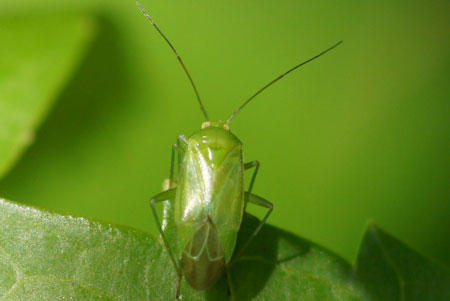 .. ..
 Nymph:
Nymph:  Common Green Capsid. (Lygocoris pabulinus). Tribe:
Mirini. Subfamily Mirinae. Family Plant Bugs,
Miridae.
Common Green Capsid. (Lygocoris pabulinus). Tribe:
Mirini. Subfamily Mirinae. Family Plant Bugs,
Miridae.
This bright green bugs can be a pest. It sucks on apples, but also on some
berries and potatoes. I see them everywhere in the garden. So far, in my garden I can't
find much damage in the apple trees.
In the autumn it lay the eggs on fruit trees. In the spring the larvae
feed on the young leaves and buds. On the photo 2-8-2008 however, the nymph is on a purple loosestrife together with
some snout beetles (Nanophyes
marmoratus).
May - October. Overwintering as an egg in woody plants (first generation) and in many other plant species (second generation).
Length: 5-6,7 mm. Holarctic.
Photos 6-9-2008, 2-6-2011. German: Grüne Futterwanze. |
 .. ..
 Lygus maritimus.
Tribe: Mirini. Subfamily Mirinae.
Family Plant Bugs,
Miridae.
Lygus maritimus.
Tribe: Mirini. Subfamily Mirinae.
Family Plant Bugs,
Miridae.
They are variable in colour. Yellow-green, light green, often partly red or dark green. Not much or no black. Sparingly hairy with fine, light hair.
On different kinds of plans.
It overwinters as an adult. Two generations in a year. From June you will see the first generation, from September the second generation.
Length: 5.4-6 mm. Europe, North Africa.
Photos 3-10-2018. |
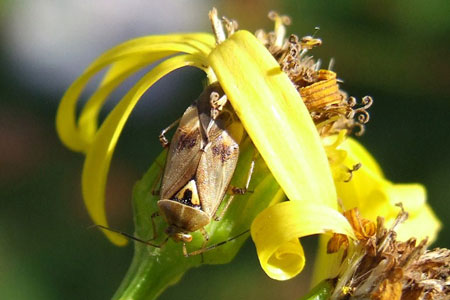 .. ..
 . .
 . .
 . .
 Lygus pratensis.
Tribe: Mirini. Subfamily Mirinae.
Family Plant Bugs,
Miridae.
Lygus pratensis.
Tribe: Mirini. Subfamily Mirinae.
Family Plant Bugs,
Miridae.
They are variable in colour. From green to brown.
The bugs suck plant sap, but also the nectar of
flowers.
It hibernates as an adult bug. One or two generations in a year. From June, you will see the first generation, from September the second generation.
Length: 5,8-7,3 mm. Palearctic, India.
Photos 22-10-2008, 6-4-2011, 27-9-2011,
25-4-2013. |
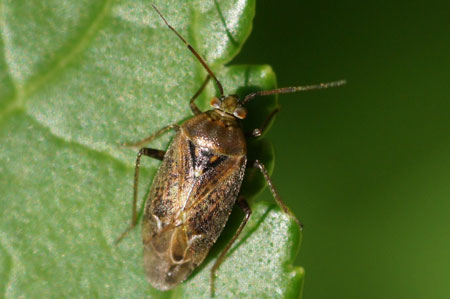 .. ..
 . .
 . .
 Tarnished plant
bug (Lygus
rugulipennis) Tribe: Mirini.
Subfamily Mirinae. Family Plant Bugs,
Miridae.
Tarnished plant
bug (Lygus
rugulipennis) Tribe: Mirini.
Subfamily Mirinae. Family Plant Bugs,
Miridae.
Lygus rugulipennis is variable in
colour from tan to purple. It is densely covered with short hairs.
It lives in many plants. Also in cultivated plants such as potatoes and cabbage. This can cause damage.
It hibernates as an adult bug. From July, you will see the first
generation, from September the second generation.
Length 5,5–6,8 mm. Holarctic.
Photos 15-10-2008,
19-9-2009, 21-9-2009, 15-10-2011. |
 |
Nymph Lygus.
According to Berend Aukema the nymphs of five Lygus species are similar. I
have photographed it early October. At the end of October I found
the Lygus pratensisin on the same Common Ragwort .
So maybe..................
|
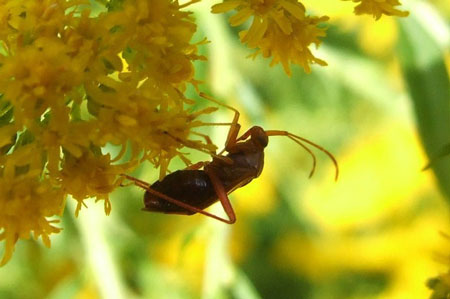 .. ..
 Megacoelum infusum Tribe:
Mirini. Subfamily
Mirinae. Family Plant Bugs
(Miridae). Megacoelum infusum Tribe:
Mirini. Subfamily
Mirinae. Family Plant Bugs
(Miridae).
It
is found on oaks and is similar to M. beckeri. A beautiful orange brown bug
with long antennae. It feeds on oak sap, but
also on small insects. Sometimes on other trees.
Adults: June - October. They overwinter as eggs on the bark or woody twigs. One generation.
Length about 6,3-7,2 mm. Palearctic. Photos 5-9-2009. |
 .. ..
 . .

 . .
 . .
 Miris striatus adult Tribe:
Mirini. Subfamily Mirinae. Family Plant Bugs
(Miridae).
Miris striatus adult Tribe:
Mirini. Subfamily Mirinae. Family Plant Bugs
(Miridae).
It's a striking yellow-orange marked bug, wich mainly
feed on lice, larvae of moths and beetles eat.
The eggs hibernate. Adult May - July. One generation. Length: 9,2-11,8 mm.
Palearctic. German: Prachtwanze, Gestreifte Weichwanze.
|
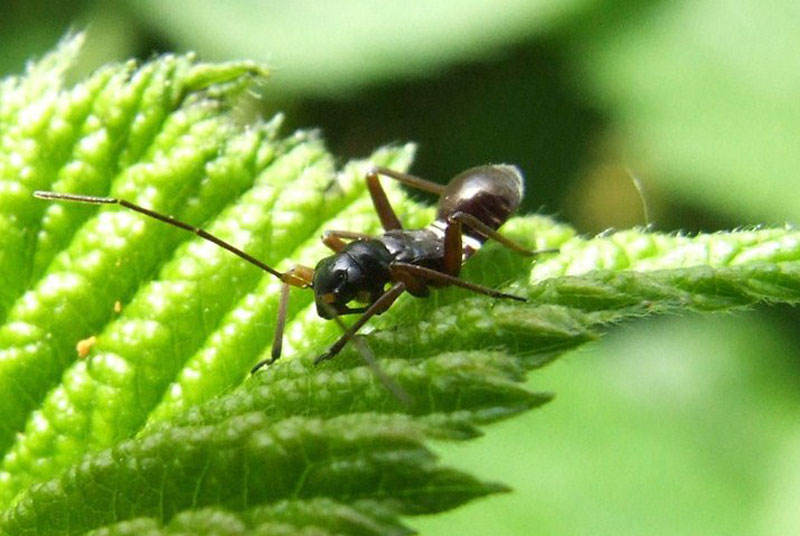 .. ..
 . .
 . .  Miris striatus nymph Tribe:
Mirini. Subfamily Mirinae. Family Plant Bugs
(Miridae). Miris striatus nymph Tribe:
Mirini. Subfamily Mirinae. Family Plant Bugs
(Miridae).
In April 2009 I found these nymphs on the leaves of a currant bush. They
are ant-like nymphs like the nymphs of the Himacerus mirmicoides. But
with
yellow markings. An older nymph on the last photos. |
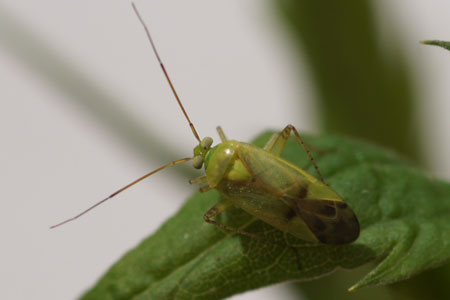 .. ..
 . .
 Neolygus contaminatus. Tribe: Mirini. Subfamily
Mirinae. Family Plant Bugs (Miridae)
Neolygus contaminatus. Tribe: Mirini. Subfamily
Mirinae. Family Plant Bugs (Miridae)
The photos were taken in June.
It is green, but lighter than the Common Green Capsid. The wings
are just a bit darker. Characteristic, I think, are the two dark spots on
the back.
The eyes are bright green. Length 4,9-6,3. In the Netherlands, there are the Neolygus
viridis (dark
top antenna, darker around scutellum) and Neolygus
populi. (shorter
antennas) |
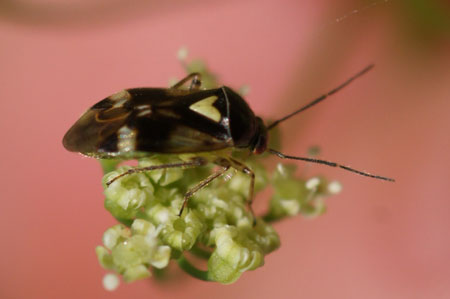 .. .. .
. . .
 Orthops basalis. Tribe:
Mirini. Subfamily Mirinae. Family Plant Bugs,
Miridae. Orthops basalis. Tribe:
Mirini. Subfamily Mirinae. Family Plant Bugs,
Miridae.
It looks a lot like the orthopedic kalmii.
In the Netherlands Orthopedic basalis is by far the commonest of the two.
The third antennal segment of an orthopedic basalis is long. The distance between the eyes
of O. kalmii is relative to the width of the eyes much smaller!
It also looks like the Nettle Capsid (Liocoris tripustulatus). But Orthops
basalis don't have dark rings on the shin and antennae.
You can find them on umbelliferous. Here it is on celery.
The adult bug overwinters. The eggs are laid in spring on young leaves of the host plant. The young green larvae appear
from May, the adults from June.
Length 4,2-5 mm. Palearctic, but now also in North America.
Photos 9-7-2010. |
 .. ..
 . .
 Orthops campestris. Tribe:
Mirini. Subfamily Mirinae. Family Plant Bugs,
Miridae. About 1 km from our house and
garden. Orthops campestris. Tribe:
Mirini. Subfamily Mirinae. Family Plant Bugs,
Miridae. About 1 km from our house and
garden.
A green little bug. The colour may vary.
You can find them on umbelliferous. Here he is on common hogweed.
The adult bug overwinters. The eggs are laid in spring on young leaves of the host plant. The young green larvae appear
from May, the adults from June.
Length 3,6-4,1 mm. Palearctic. Photos 11-7-2014. |
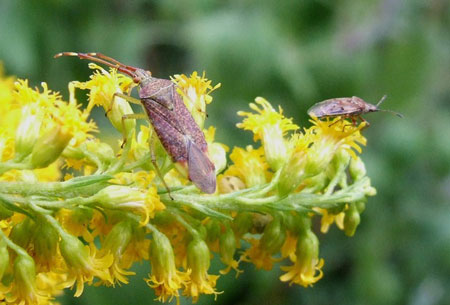 .. ..
 . .
 . .
 Pantilius tunicatus. Tribe:
Mirini. Subfamily Mirinae. Family Plant Bugs,
Miridae. Pantilius tunicatus. Tribe:
Mirini. Subfamily Mirinae. Family Plant Bugs,
Miridae.
The bugs are red with dark speckles. The older bugs are darker red. The first antenna segments are thicker than the other.
The photo shows also a Kleidocerys resedae.
You can find them in birch, alder and hazel.
July - October. They overwinter as eggs in the young twigs. One generation. Early July the green nymphs appear.
Length 8,5-10,2 mm. Palearctic.
Photos 2-9-2009. |
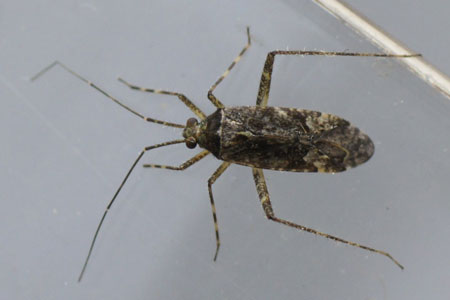 .. ..
 . .
 Phytocoris dimidiatus. Subgenus Phytocoris.
Tribe: Mirini
Subfamily Mirinae. Family Plant Bugs
(Miridae). Phytocoris dimidiatus. Subgenus Phytocoris.
Tribe: Mirini
Subfamily Mirinae. Family Plant Bugs
(Miridae).
This bug is densely dark mottled. Only the pronotum is dark without spots. The hind legs are long. On the shin (tibia) are light bands. In this species, these
bands are equal to or narrower than the dark bands. It looks a lot like Phytocoris
reuteri. According to Berend Aukema:
(translated) Male Phytocoris dimidiatus (width pronotum , length of second
antennal segment and width vertex are clearly visible in these pictures!
It is found in deciduous trees, often fruit trees like apple, pear, plum, but occasionally also include oak, beech, ash. Food consists of both plant diet as animal diet.
June- October One generation, maybe two generations.
The eggs overwinter.
Length 5,3-7 mm. Palearctic.
Photos 24-6-2013. |
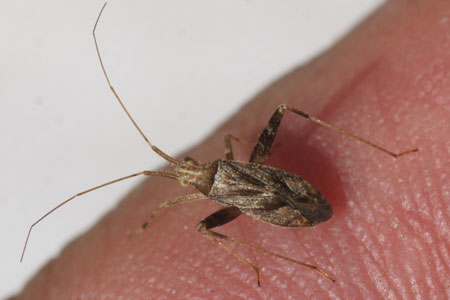 .. ..
 Phytocoris. Tribe: Mirini.
Subfamily Mirinae. Family Plant Bugs
(Miridae). Not in the garden, but in the
dunes about 4 km from our home. Phytocoris. Tribe: Mirini.
Subfamily Mirinae. Family Plant Bugs
(Miridae). Not in the garden, but in the
dunes about 4 km from our home.
Phytocoris can be divided into two subgenera. The species are very difficult to identify.
I've put a few photos on this page, which I've taken in the dunes of Phytocoris species of the subgenus
Ktenocoris.
Subgenus Phytocoris. Colour is yellowish gray, brownish to greenish with irregular blackish brown or gray spots, which merge. Black antennae with pale rings.
Subgenus Ktenocoris: Colour is brownish, reddish or yellowish. Light antennas. Antenna segment 3 is light. Shins with narrow dark rings, however they are often lacking.
Photos 23-8-2016. |
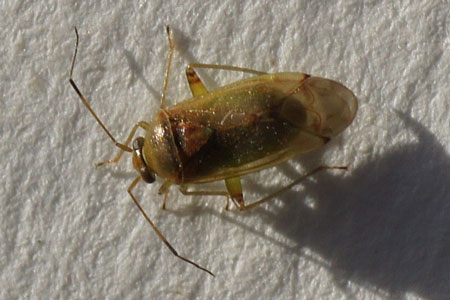 .. ..
 . .
 . .
 Pinalitus cervinus. Tribe:
Mirini. Subfamily Mirinae. Family Plant Bugs
(Miridae). Pinalitus cervinus. Tribe:
Mirini. Subfamily Mirinae. Family Plant Bugs
(Miridae).
The colour of this bug is variable. Pale brown, brown and green. The first antennal segment is
pale. The second antennal segment is also pale, but has a dark tip. The wings are slightly transparent.
The cuneus is white with a dark tip (sometimes red).
Particularly in lime trees, but also on other plants as a buxus, ivy.
Length about 3,8-4,4 mm. Palearctic, but now also in Canada.
Throughout the year. It hibernates as an adult bug. Two generations.
Photos 13-1-2012 and 13-9-2012 to 24-9-2018. Nymphs I found in the ivy,
growing up into images..



 Collage and molted skins.
Collage and molted skins. |
 .. ..
 Striped Oak Bug, Rhabdomiris striatellus. Tribe: Mirini. Subfamily Mirinae. Family Plant Bugs
(Miridae).
Striped Oak Bug, Rhabdomiris striatellus. Tribe: Mirini. Subfamily Mirinae. Family Plant Bugs
(Miridae).
A plant bug with striped wings and a striking pale cuneus.
The nymphs live from the inflorescences of oak, the adult bugs mainly feed
on insects such as aphids (Aphidoidea), caterpillars from Tortricidae and larvae from other plant bugs.
The eggs overwinter. The adults at the end of April to the end of July. Length 7-8.4 mm. Europe, Asia. Photos 23-5-2019. |
.
Tribe: Stenodemini. Elongated shaped bugs.
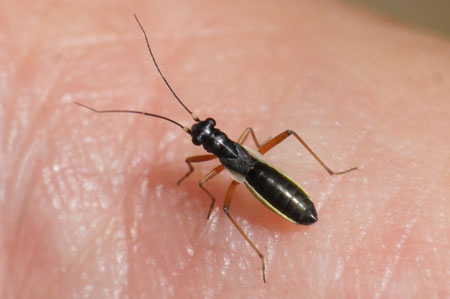 .. ..
 Pithanus maerkelii. Subfamily Mirinae. Tribe: Stenodemini. Family Plant Bugs
(Miridae).Not in the garden, but in the
dunes about 4 km from our home.
Pithanus maerkelii. Subfamily Mirinae. Tribe: Stenodemini. Family Plant Bugs
(Miridae).Not in the garden, but in the
dunes about 4 km from our home.
A small bug, which resembles an ant. It is micropterous, although the female
sometimes do occur fully-winged. It's a black bug, but the connexivum (protruding edge of the
abdomen, the edges of the wings and the first antenna segment are pale. The legs are reddish brown.
It feeds on grasses. It lives in grasslands. Male: 3,7-4,1 mm. Female 4,4-5,3 mm.
Palearctic, now also in North America.
The eggs overwinter in the stems of grasses. May - September.
Photo 6-7-2015, female. Small photo 20-7-2015, male. |
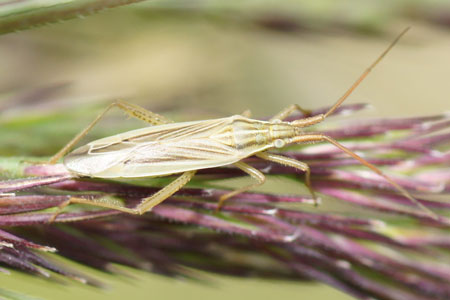 .. ..
 . .
 . .
 . .
 Nymph:
Nymph:  . .
 Stenodema calcarata. Subfamily
Mirinae. Tribe: Stenodemini. Family Plant Bugs (Miridae). Stenodema calcarata. Subfamily
Mirinae. Tribe: Stenodemini. Family Plant Bugs (Miridae).
The first photos were taken in the dunes, but in 2017 I sometimes see them in the garden.
Females are green and the males straw-colored. Head and pronotum with dark stripes.
It has a long and a short spur on the hind femora (the nymph one)
Length 6.8-7.9 mm. Palearctic: Europe, North Africa, Asia.
The adult bug overwinters. Then the colour of the female is straw-colored and of the male brown.
Photos 7-7-2016, 4-8-2017, 21-8-9-2017, 27-8-2017. |
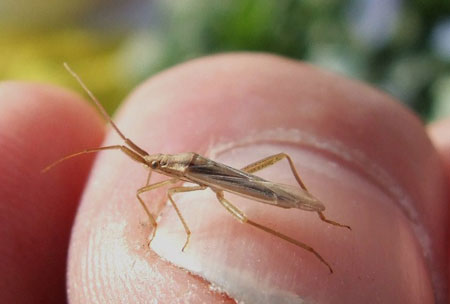 .. ..
 . .
 . .
 Green:
Green:  . .
 Stenodema laevigata. Subfamily
Mirinae. Tribe: Stenodemini. Family Plant Bugs
(Miridae).
Stenodema laevigata. Subfamily
Mirinae. Tribe: Stenodemini. Family Plant Bugs
(Miridae).
A long, slender bug. You can confuse him with Notostira elongata.
Difference: There is a notch in the underside of the hind
femora, near the apex.
It is also very similar to the Stenodema calcarata and Stenodema
trispinosa. But they have two spines inside of the rear thigh.
(femoral spurs)
It hunts in the grass. By its body shape and colour it is difficult to
find.
Length 7,8-9 mm. Palearctic.
The adult bug overwinters. Then its colour is brown. In spring it turn
green. Photos 14-4-2010, 25-6-2015. |
 .. ..
 . .
 . .  Nymph: Nymph:
 Notostira elongata. Subfamily Mirinae. Tribe:
Stenodemini. Family Plant Bugs
(Miridae). Not in the garden but about 2
and 3 km from our house. Notostira elongata. Subfamily Mirinae. Tribe:
Stenodemini. Family Plant Bugs
(Miridae). Not in the garden but about 2
and 3 km from our house.
The females are straw-colored to green. The males are yellowish green with a broad black
part on the upperside, which runs from head to end of the forewings. On the head two light spots.
Length 6-8.7 mm. Palearctic: Europe, North Africa, Asia.
Adult bugs of the first generation: End May to end of July. Adult bugs of the second generation: From early August.
The autumn generation mate and particulary the females overwinter.
Photos 28 -8-2017,
23-8-2017. |
Subfamily Orthotylinae.
Tribe Halticini. Often completely black with a wide short head. A big difference in shape between males and females. Males
macroptery and slim. Females brachyptery and oval to round.
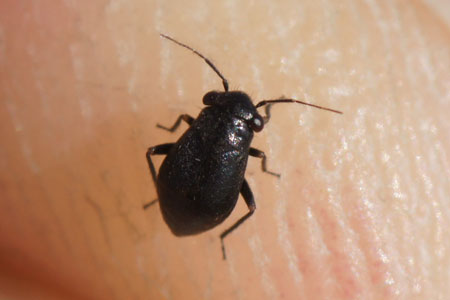 .. ..
 Pachytomella parallela. Tribe Halticini. Subfamily
Orthotylinae. Family Plant Bugs
(Miridae). Not in the garden but about 2 km from our house. Pachytomella parallela. Tribe Halticini. Subfamily
Orthotylinae. Family Plant Bugs
(Miridae). Not in the garden but about 2 km from our house.
A shiny black bug with fine, brown, lying hairs.
Male: macroptery, elongate, 3.2-3.8 mm. Female: Brachyptery. oval, 2.1-2.5 mm.
In biotopes with grass like meadows and roadsides. Presumably they suck on
grasspots, but it has not been established.
May - November. The eggs overwinter. Probably two generations.
Palearctic.
Foto's 28-8-2016. |
Tribe: Orthotylini. A large group. Variable in shape and
colour.
 .. ..
 Black Kneed Capsid (Blepharidopterus
angulatus). Tribe: Orthotylini. Subfamily Orthotylinae. Family Plant Bugs
(Miridae).A slender green plant bug with dark "knees". On the back you can see a dark stripe. The males have long antennae. Black Kneed Capsid (Blepharidopterus
angulatus). Tribe: Orthotylini. Subfamily Orthotylinae. Family Plant Bugs
(Miridae).A slender green plant bug with dark "knees". On the back you can see a dark stripe. The males have long antennae.
They can be found in different deciduous trees. It is partly a predator. (especially red mites) June - October. They overwinter as eggs in one and two-year-old twigs. One generation.
Length 4,8-5,9 mm. Palearctic, but now also in North America.
Photos 18-8-2014.
 Nimph 13-7-2022 .
Nimph 13-7-2022 . |
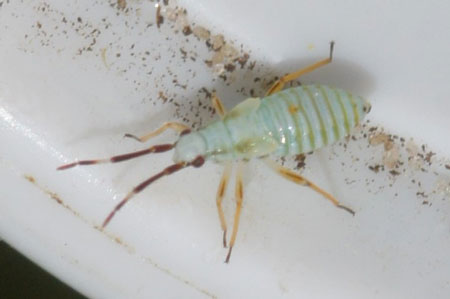 Cyllecoris histrionius. Tribe: Orthotylini. Subfamily
Orthotylinae. Family Plant Bugs
(Miridae). Not in the garden, but in the
dunes about 4 km from our home. Cyllecoris histrionius. Tribe: Orthotylini. Subfamily
Orthotylinae. Family Plant Bugs
(Miridae). Not in the garden, but in the
dunes about 4 km from our home.
Only a photo of the bluish-green coloured nymph, which is easily recognizable. The adult bug has a black head is strikingly colored.
In oak. Young nymphs live on juices, older bugs mainly on aphids, leaf fleas, etc.
April - end of July. The eggs overwinter. One generation.
Length 5.7-8 mm. Palearctic.
Photo 11-7-2018. |
 .. ..
 Four-spotted oak bug
(Dryophilocoris flavoquadrimaculatus).
Tribe Orthotylini. Subfamily Orthotylinae. Family Plant Bugs
(Miridae). (200 meter from our home) Four-spotted oak bug
(Dryophilocoris flavoquadrimaculatus).
Tribe Orthotylini. Subfamily Orthotylinae. Family Plant Bugs
(Miridae). (200 meter from our home)
A black plant bug with four striking yellow spots. In oak.
April - June. The eggs overwinter. One generation.
Length about 6-6,6 mm. Palearctic.
Photos 16-6-2016.
 5-5-2025.
Finally in our garden on an elm leaf. 5-5-2025.
Finally in our garden on an elm leaf. |
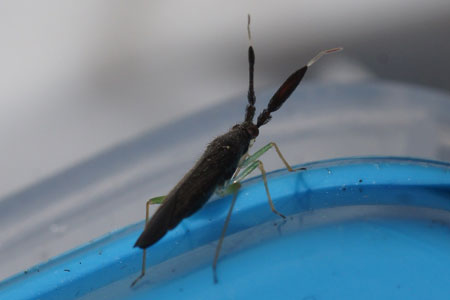 .. ..
 . .  Heterotoma planicornis synonym Heterotoma
merioptera. Tribe: Orthotylini. Subfamily
Orthotylinae. Family Plant Bugs
(Miridae). Heterotoma planicornis synonym Heterotoma
merioptera. Tribe: Orthotylini. Subfamily
Orthotylinae. Family Plant Bugs
(Miridae).
A slim small dark plant bug with strange shaped antennae.
The second antennal segment is broad and flattened. The legs are light
green.
In June, I photographed the nymphs. The adult bugs are
found from July to September. The eggs overwinter. One generation.
The bug feeds on aphids and other small insects, but sucks pant juice as
well. On the left photo it has a thrips.
Length 4,6-5,5 mm. Europe, but now also in north America. Photos 6-7-2011,
4-8-2013, 5-6-2018, 11-6-2018.
German: Breitfühler-Weichwanze


  Nymphs Heterotoma planicornis from young to old.
Nymphs Heterotoma planicornis from young to old. |
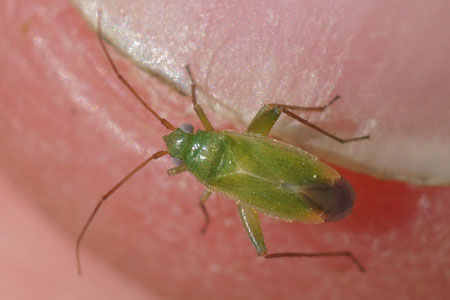 .. ..
 Nymph: Nymph:
 Orthotylus ericetorum. Tribe: Orthotylini. Subfamily
Orthotylinae. Family Plant Bugs
(Miridae). Not in the garden, but in the
dunes about 4 km from our home. Orthotylus ericetorum. Tribe: Orthotylini. Subfamily
Orthotylinae. Family Plant Bugs
(Miridae). Not in the garden, but in the
dunes about 4 km from our home.
A green bug, which can be found on heather. It is covered with erect hairs. With its long hind legs,
it moves a bit jumpy. The cunus is yellowish. It lives on heather (Calluna
vulgaris), but it also can be found sometimes on cross-leaved heath (Erica
tetralix). They suck in particular on the seeds, but they can also suck on
other parts of the plant.
June - october. The eggs overwinter on the young shoots. One generation.
Length about 2.5-3.6 mm. Palearctic.
Photos 25-8-2015, 1-8-2016. |
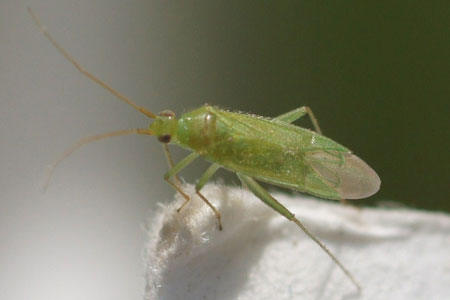 .. ..
 . .
 Orthotylus cf prasinus. Tribe:
Orthotylini. Subfamily Orthotylinae. Family Plant Bugs
(Miridae). Orthotylus cf prasinus. Tribe:
Orthotylini. Subfamily Orthotylinae. Family Plant Bugs
(Miridae).
cf means not sure. There are some very similar species in this genus. They are mainly green. The plant, in which they are found, may be important. However, this was on the wall of the toilet. Most likely, it was on our clothes. Because we had been in Rotterdam the day before, it is also possible it is a bug from Rotterdam.
In deciduous trees like elm and hazel.
June - September. The eggs overwinter. One generation.
Length about 4,3-5 mm. Palearctic.
Photos 10-7-2011. |
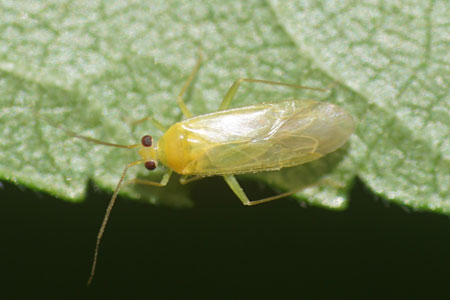 .. ..
 . .
 Orthotylus
tenellus. Tribe Orthotylini. Subfamily
Orthotylinae. Family Plant Bugs
(Miridae). Orthotylus
tenellus. Tribe Orthotylini. Subfamily
Orthotylinae. Family Plant Bugs
(Miridae).
The male is whitish yellow or yellow. The female whitish green. Oblong in shape. A pale membrane. Pale green legs, sometimes yellowish.
Zoophytophage. Deciduous trees such as oak (Quercus), ash (Fraxinus) and hazel (Corylus avellana). Occasionally on other trees with many aphids. Mid May - September. The eggs overwinter. One generation. 4.1-4.9 mm. Palearctic. Photos 9-6-2019. |
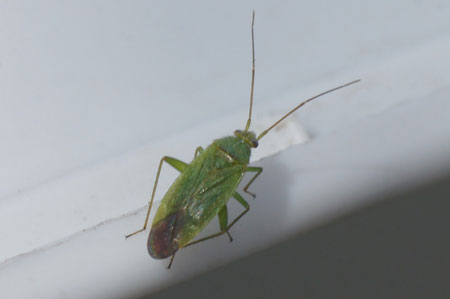 .. ..
 . .
 . .
 . .  Nymph:
Nymph:  Orthotylus virescens. Tribe: Orthotylini.
Subfamily Orthotylinae. Family Plant Bugs
(Miridae). Not in the garden, but in the
dunes about 4 km from our home. Orthotylus virescens. Tribe: Orthotylini.
Subfamily Orthotylinae. Family Plant Bugs
(Miridae). Not in the garden, but in the
dunes about 4 km from our home.
In the Netherlands there are three very similar green species: Orthotylus adenocarpi (light hairs), Orthotylus concolor (light and dark
haisr), Orthotylus virescens (dark hairs, see detail photo and short rpstrum short, shorter than the other two).
They live from broom juice and among others aphididae (Aphidoidea).
End of May - October. The eggs pverwinter. One generation.
Length 3.8-4.9 mm. Palearctic.
Photos 21-6-2017. Nymph, not quite sure, because sometimes several different species are in broom. |
Subfamily Orthotylinae.
Tribe: Pilophorini. A small group of bugs, antlike.
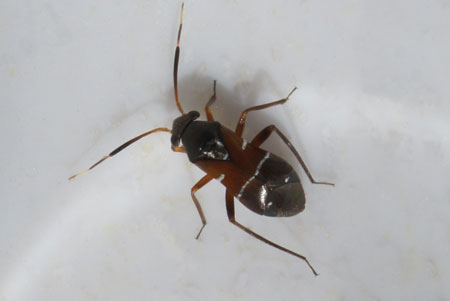 .. ..
 Pilophorus cinnamopterus. Tribe:
Pilophorini. Family Plant Bugs
(Miridae). Not in the garden, but in the
dunes about 4 km from our home. Pilophorus cinnamopterus. Tribe:
Pilophorini. Family Plant Bugs
(Miridae). Not in the garden, but in the
dunes about 4 km from our home.
It looks like the Pilophorus Perplexus, but it is mainly in pine (Pinus)
and occasionally it is found in spruce. The colour is more orange brown. The white band runs across the forewings.
It is predatory and mainly feeds on the aphids of the family Lachnidae, but he also
sucks at the needles and buds.
July - October. They overwinter as eggs on young twigs. One generation.
Length 4.1-5.2 mm. Palearctic, but also in North America. Photos 25-8-2015. |
Tribe: Phylini. A large and variable group.
 .. ..
 . .
 Atractotomus
mali. Tribe: Phylini. Subfamily
Orthotylinae. Family Plant Bugs
(Miridae). Atractotomus
mali. Tribe: Phylini. Subfamily
Orthotylinae. Family Plant Bugs
(Miridae).
A dark little bug covered with pale hairs. The second segment of the antenna is thickened
like the Heterotoma. The first segment is also thick, but is much thinner at the base.
They can be found on apple and hawthorn. On this photo it is on a young apple. These are also the food
plants, but it is also partly predatory.
June-August. They overwinter as eggs in the young wood. One generation.
Length: 3-3,6 mm. So tiny. Palearctic, but now also in North America.
There are two similar members of the family. Namely A. magnicornis, A. parvulus. They
live in other plants. Photos 14-6-2011, 10-7-2015. |
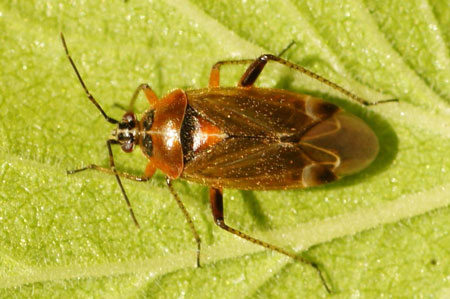 . .
 . .
 . .
 . .  Harpocera thoracica. Tribe:
Phylini. Subfamily Orthotylinae. Family Plant Bugs
(Miridae). Harpocera thoracica. Tribe:
Phylini. Subfamily Orthotylinae. Family Plant Bugs
(Miridae).
They don't look alike, but both
are Harpocera thoracica. The left wants is the female. The
right one is the male. The male has a distinctive inflated second antennal
segment.
These photos were taken in May. They are common in May. They live about a
month. Then you have to wait another year, before you see them again. They overwinter as eggs on young twigs.
The
larvae develop in about two weeks. Palearctic.
They live in oaks. They suck juices of the oak, but they also feed on
aphids.
Length: 6-6,8 mm. Photos female 14-5-2014, male 14-5-2009. M
ale, female 31-5-2013. German: Eichenwanze. |
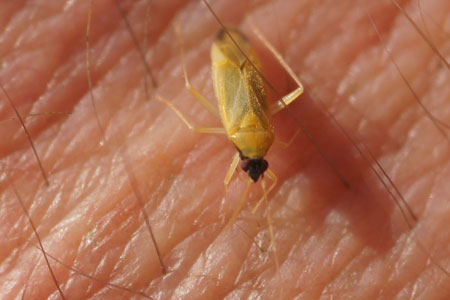 Phylus melanocephalus.
Tribe: Phylini. Subfamily Orthotylinae. Family Plant Bugs
(Miridae) Phylus melanocephalus.
Tribe: Phylini. Subfamily Orthotylinae. Family Plant Bugs
(Miridae)
This bug stung me in my hand, when I was working in the garden. It did not hurt. I took my camera. But it is not easy to photograph your right hand with your left hand. When I tried to move the bug, it escaped.
This Phylus has a striking dark head (not always), while the rest of the body
is pale.
It is partly a predatory bug and you can find it in oak. There are three species Phylus in the Netherlands.
June - August. They overwinter as eggs on young twigs. One generation.
Length 4,4-6,1 mm. Palearctic. Photo 25-5-2011. |
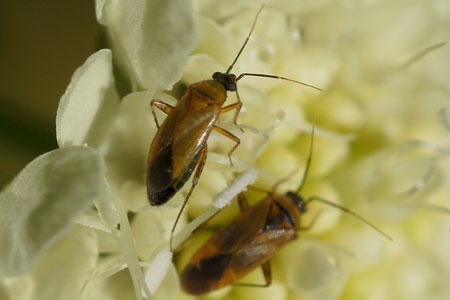 .. ..
 Nymph:
Nymph:  Plagiognathus arbustorum. Tribe:
Phylini. Subfamily Orthotylinae. Family:Plant Bugs,
Miridae. Plagiognathus arbustorum. Tribe:
Phylini. Subfamily Orthotylinae. Family:Plant Bugs,
Miridae.
The light coloured bug is a female. The
colour is variable. The thighs have above and below a black stripe. The males are often darker.
They live on nettles. But they are also on many other plants. Their food consists of honeydew, sap from flower buds and flowers, but also from small insects like aphids.
June - September. They overwinter as eggs. One generation. But sometimes there seems to be a second generation whose adult bug can
overwinter.
Length 3,7-4,6 mm. Palearctic, but now also in North America.
Photos 24-6-2008, 2-8-2010, 11-8-2010. 2-7-2017. |
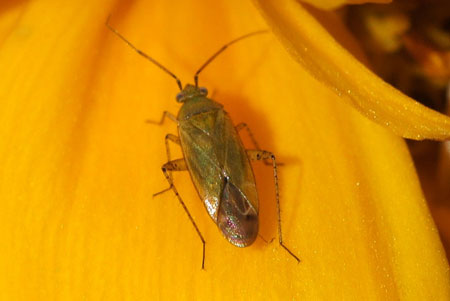 .. ..
 . .
 Plagiognathus chrysanthemi. Tribe: Phylini. Subfamily
Orthotylinae. Family Plant Bugs
(Miridae).
Plagiognathus chrysanthemi. Tribe: Phylini. Subfamily
Orthotylinae. Family Plant Bugs
(Miridae).
A small green bug with a dense hairs. It is easily recognized by their pale legs with dark hair and dark
spots. Often on plants from the composite family, like Ragwort and yarrow.
June - September. They overwinter as eggs. One generation.
Length 3,2-4,1 mm. Palearctic, but now also in North America.
Photos 18-6-2011. |
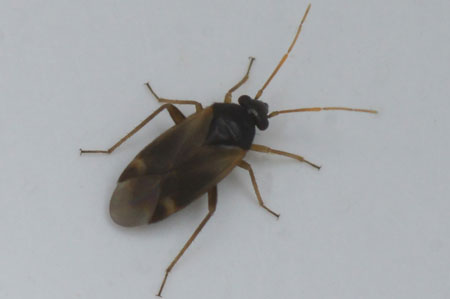 Nymph: Nymph:
 Plesiodema pinetella. Synonym Plesiodema pinetellum. Tribus
Phylini. Subfamily Phylinae. Family Plant Bugs
(Miridae).
Not in the garden, but in the
dunes about 4 km from our home. Plesiodema pinetella. Synonym Plesiodema pinetellum. Tribus
Phylini. Subfamily Phylinae. Family Plant Bugs
(Miridae).
Not in the garden, but in the
dunes about 4 km from our home.
The Plesiodema pinetella its head, pronotum and scutellum are shiny black, black or brown. The forewings are lighter.
They live in pine and feed on pine juices and small insects.
May - late July. They overwinter as eggs. One generation in a year.
Length 2.6-3.5 mm. Palearctic. Europe, North Africa, Asia and Far East.
Photo 22-6-2016, 26-5-2016. |
 Psallus perrisi / Psallus wagneri. Tribe:
Phylini. Subfamily Orthotylinae. Family Plant Bugs
(Miridae)
male. Psallus perrisi / Psallus wagneri. Tribe:
Phylini. Subfamily Orthotylinae. Family Plant Bugs
(Miridae)
male.
They
are very similar (Difference genitals.) Both species occur on oak.
It is a brown-black bug. The males are darker than females. The upper
surface is covered with golden hairs. The thighs are dark. Pale
antennae.
May - August / July. They overwinter as eggs. One generation.
Length 3-4 mm. Palearctic. Photo 19-6-2010. |
 .. ..
 Psallus varians. Tribe: Phylini.
Subfamily Orthotylinae. Family Plant Bugs
(Miridae). This is a hairy,
light brown bug. It lives in oaks.May - August. They overwinter as eggs. One generation.
Length 3,8-4,6 mm. Palearctic. Photos 21-5-2011.
Psallus varians. Tribe: Phylini.
Subfamily Orthotylinae. Family Plant Bugs
(Miridae). This is a hairy,
light brown bug. It lives in oaks.May - August. They overwinter as eggs. One generation.
Length 3,8-4,6 mm. Palearctic. Photos 21-5-2011. |
 .. ..
 . .
 Psallus betuleti / Psallus montanus.
Tribe: Phylini. Subfamily Orthotylinae. Family Plant Bugs
(Miridae) male. Psallus betuleti / Psallus montanus.
Tribe: Phylini. Subfamily Orthotylinae. Family Plant Bugs
(Miridae) male.
Males are black brown. May - August. Length 5,2-5,7 mm. Photos
16-5-2011 |
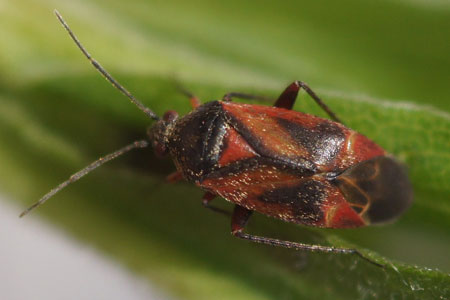 .. ..
 Psallus betuleti / Psallus montanus.
Tribe: Phylini. Subfamily Orthotylinae. Family Plant Bugs
(Miridae) female. Psallus betuleti / Psallus montanus.
Tribe: Phylini. Subfamily Orthotylinae. Family Plant Bugs
(Miridae) female.
Maybe Psallus montanus, but.... not certain. Palearctic. They overwinter as eggs. One generation.
Photos 30-5- 2011. |
 |
Probably Psallus betuleti / Psallus montanus. Nymph.
Photo 12-6-2012.
|
I want to thank Berend Aukema for the determination of many of my bugs.
Nederlands /
Dutch
 
Subpage bugs in
the garden: "Water
bugs"
Shield
bugs (Pentatomoidea)
Seed
bugs (Lygaeidae)
Cicadas
Aphids
Subpage France:
Insects
France
|
